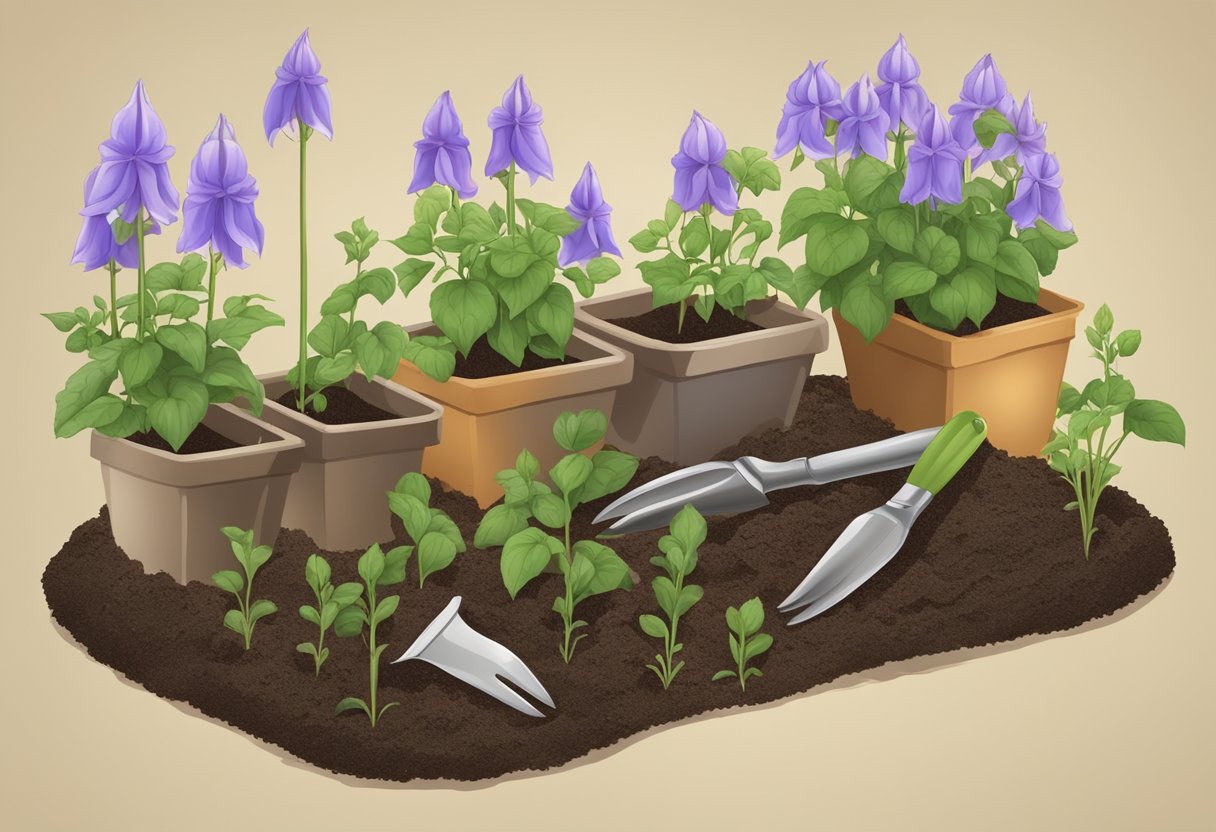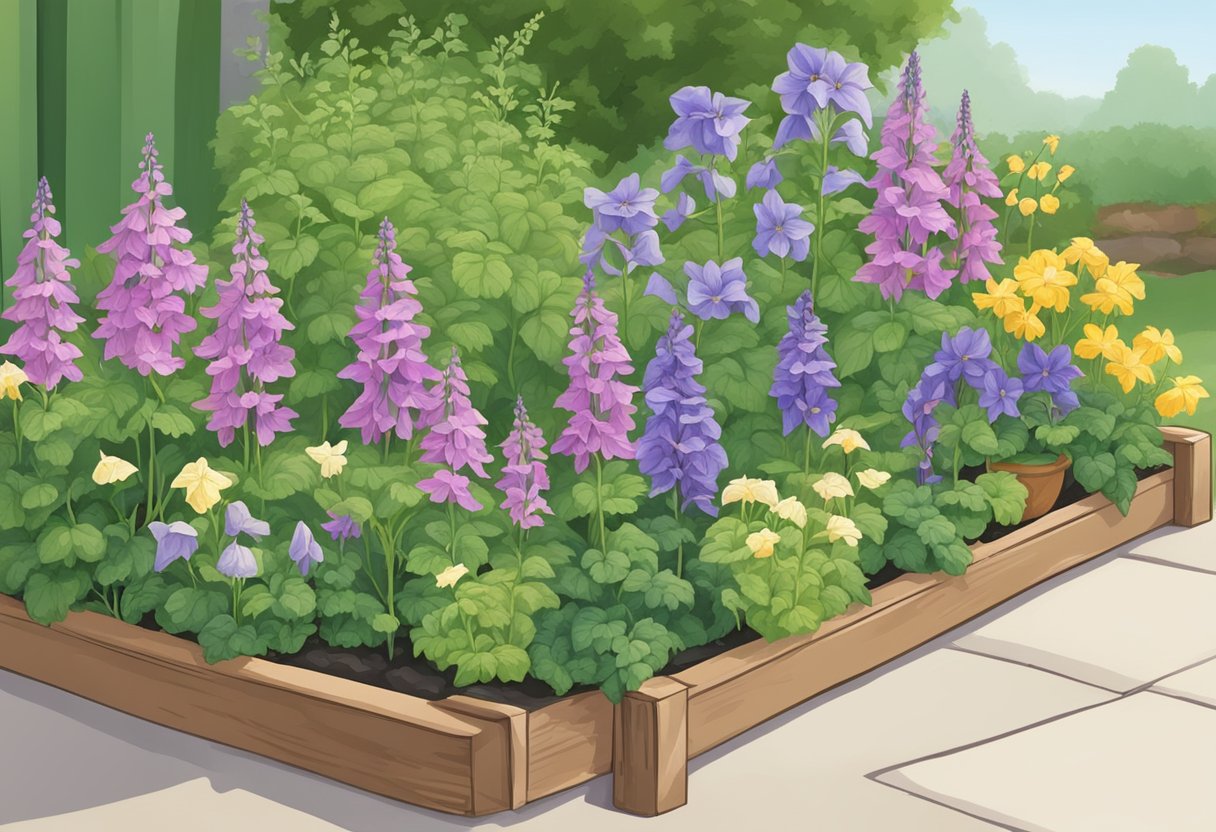Campanula: Where to Plant for Optimal Growth
Campanula, also known as bellflower, is a popular perennial plant that is known for its beautiful bell-shaped flowers and low maintenance requirements. This plant is a great addition to any garden or landscape due to its versatility and ability to thrive in a variety of conditions. However, choosing the right location to plant campanula is crucial for its success.

When selecting a location to plant campanula, it is important to consider the plant’s sunlight and soil requirements. Campanula typically prefers full to partial sunlight and well-draining soil. In addition, it is important to choose a location that provides adequate space for the plant to grow and spread. Campanula can grow up to 3 feet tall and wide, so it is important to consider its potential size when choosing a planting location.
Overall, campanula is a beautiful and low maintenance perennial plant that can add color and texture to any garden or landscape. By selecting the right location to plant campanula and providing it with proper care, gardeners can enjoy its beauty for years to come.
Choosing the Right Location

When it comes to growing campanula, choosing the right location is crucial to ensure healthy growth and blooming. This section will cover the three main factors to consider when choosing a location for campanula: sunlight requirements, soil conditions, and temperature and hardiness zones.
Sunlight Requirements
Campanula plants thrive in a location that receives full sun to partial shade. Full sun is ideal for most varieties of campanula, but some can tolerate partial shade. It is important to note that too much shade can result in weak stems and poor blooming. Therefore, it is recommended to plant campanula in a location that receives at least 4-6 hours of sunlight per day.
Soil Conditions
Campanula prefers well-drained soil that is rich in organic matter. It is important to avoid planting campanula in heavy clay soils or areas with poor drainage, as this can lead to root rot. Before planting, amend the soil with compost or other organic matter to improve soil structure and fertility. Additionally, it is recommended to maintain a slightly acidic to neutral soil pH of 6.0-7.0 for optimal growth.
Temperature and Hardiness Zones
Campanula is generally hardy in USDA hardiness zones 3-8, depending on the variety. It is important to choose a location that is suitable for the specific variety of campanula being planted. Additionally, it is recommended to plant campanula in the spring or fall, when temperatures are mild and there is ample moisture in the soil to promote root growth.
Overall, choosing the right location for campanula is essential to ensure healthy growth and blooming. By considering the plant’s sunlight requirements, soil conditions, and temperature and hardiness zones, gardeners can create an ideal growing environment for this beautiful plant.
Planting Campanula
Campanula is a genus of flowering plants that are easy to grow and care for. They are perfect for gardens, borders, and containers. Here are some tips on planting campanula:
Best Time to Plant
Campanula can be planted in the spring or fall. However, the best time to plant campanula is in the early spring, after the last frost. This will give the plant enough time to establish its roots before the hot summer months.
Planting Seeds and Seedlings
Campanula can be grown from seeds or seedlings. If you are starting from seeds, sow them in early spring, indoors or outdoors. The seeds should be planted 1/8 inch deep and kept moist until they germinate. If you are starting from seedlings, plant them in the early spring or fall. Dig a hole that is twice the size of the root ball and place the plant in the hole. Fill the hole with soil and water the plant.
Spacing and Depth
When planting campanula, make sure to space the plants 12 to 18 inches apart. This will give them enough room to grow and spread. The depth of the hole should be the same as the root ball. Make sure the top of the root ball is level with the soil surface.
In conclusion, campanula is a beautiful and easy-to-grow plant that can add color and texture to any garden. By following these simple planting tips, you can ensure that your campanula will thrive and bloom for years to come.
Campanula Care
Campanula is a beautiful and easy-to-care-for plant that can be grown in a variety of locations. Proper care is essential to ensure that your Campanula thrives and produces abundant blooms. Here are some tips to help you care for your Campanula.
Watering and Moisture
Campanula prefers well-draining soil that is moist but not waterlogged. Water your Campanula deeply once or twice a week, depending on the weather and soil conditions. Be careful not to overwater, as this can lead to root rot. It is best to water in the morning or evening when the temperatures are cooler to avoid water evaporation.
Fertilizing and Soil Nutrition
Campanula thrives in fertile soil with a pH between 6.0 and 7.0. Incorporate compost or well-rotted manure into the soil before planting to improve soil fertility. Fertilize your Campanula every two weeks with a balanced fertilizer during the growing season to promote healthy growth and abundant blooms.
Pruning and Deadheading
Campanula does not require much pruning, but deadheading can help promote continuous blooming. Remove spent blooms by cutting the stem just above the first set of leaves below the flower. This will encourage new blooms to form.
Mulching and Winter Protection
Mulching can help retain moisture in the soil and regulate soil temperature. Apply a layer of organic mulch around the base of your Campanula to help suppress weeds and retain moisture. In colder climates, Campanula may require winter protection. Apply a layer of mulch or straw around the base of the plant to help insulate the roots from the cold.
By following these simple tips, you can ensure that your Campanula thrives and produces beautiful blooms year after year.
Common Varieties of Campanula

Campanula, commonly known as bellflowers, is a genus of flowering plants that consists of over 300 species. These plants are known for their delicate bell-shaped flowers and are a popular choice for gardens and landscapes. In this section, we will discuss some of the most common varieties of Campanula.
Bellflower Species
The Bellflower species are the most common and well-known varieties of Campanula. They are native to many regions across the globe, including Europe, Asia, and North America. Bellflowers are known for their bell-shaped flowers that come in a variety of colors, including blue, purple, pink, and white. They are a popular choice for borders, rock gardens, and cottage gardens.
Campanula Persicifolia
Campanula Persicifolia, also known as the Peach-Leaved Bellflower, is a popular variety of Campanula. It is a perennial plant that is native to Europe and Asia. This variety is known for its tall stems that can grow up to 3 feet tall and its delicate blue or white flowers that bloom in the summer. Campanula Persicifolia is a great choice for borders, rock gardens, and cottage gardens.
Serbian Bellflower
The Serbian Bellflower, also known as Campanula poscharskyana, is a low-growing perennial that is native to the Balkans. It is a popular choice for ground cover and is known for its delicate blue or white flowers that bloom in the summer. Serbian Bellflowers are easy to grow and are a great choice for rock gardens and borders.
In conclusion, Campanula is a diverse genus of flowering plants that offers a wide variety of options for gardeners and landscapers. Whether you are looking for a tall perennial or a low-growing ground cover, there is a Campanula variety that will fit your needs.
Design and Landscape Use

Campanula is a versatile plant that can be used in various landscape designs. Its delicate, bell-shaped flowers and lush foliage make it a popular choice for garden borders, container gardening, rock gardens, and ground cover.
Garden Borders and Edges
Campanula is an excellent choice for garden borders and edges. Its compact size and low-growing habit make it perfect for defining the edges of garden beds. It can also be planted in groups to create a stunning border that adds color and texture to the garden. Campanula can be planted in full sun to partial shade, and it prefers well-draining soil.
Container Gardening
Campanula is an ideal plant for container gardening. Its small size makes it perfect for small pots and hanging baskets. It can be planted alone or mixed with other plants to create a colorful display. Campanula prefers well-draining soil, and it should be watered regularly to keep the soil moist.
Rock Gardens and Ground Cover
Campanula is a popular choice for rock gardens and ground cover. Its low-growing habit and ability to spread make it ideal for filling in gaps between rocks or as a ground cover in shady areas. Campanula can be planted in full sun to partial shade, and it prefers well-draining soil.
Overall, campanula is a versatile plant that can be used in various landscape designs. Whether you’re looking to create a stunning border, add color to your container garden, or fill in gaps in your rock garden, campanula is an excellent choice. With its delicate flowers and lush foliage, campanula is sure to add beauty and charm to any garden.
Propagation and Division

Dividing Perennials
Campanula can be propagated by division, which is the process of separating a mature plant into smaller sections. This is typically done in the spring or fall when the plant is not actively growing. To divide a campanula plant, carefully dig up the entire plant and gently separate the root ball into smaller sections. Each section should have at least one healthy shoot and a portion of the root system.
It is important to ensure that each section has enough roots to support its growth. Once the sections have been separated, replant them in well-draining soil and water thoroughly. Dividing perennials can help to rejuvenate an older plant and encourage new growth.
Growing from Cuttings
Campanula can also be propagated from cuttings. This method involves taking a stem cutting from a healthy plant and rooting it in soil or water. To take a cutting, select a healthy stem and make a clean cut just below a node. Remove the lower leaves and dip the cut end in rooting hormone.
Place the cutting in soil or water and keep it moist until roots begin to form. Once the cutting has established roots, it can be transplanted into a larger container or directly into the garden. Growing from cuttings can be a quick and easy way to produce new plants, but it is important to ensure that the cutting is taken from a healthy plant to ensure successful propagation.
Overall, campanula is a hardy plant that can be easily propagated through division or cuttings. Dividing perennials can help to rejuvenate an older plant, while growing from cuttings can quickly produce new plants. With the right care and attention, campanula can thrive and add beauty to any garden.
Pests and Diseases

Common Pests
Campanula plants are generally resistant to pests, but they can be occasionally affected by aphids. These small insects can be found on the leaves and stems of the plant and can cause damage to the foliage. To control aphids, it is recommended to use insecticidal soap or neem oil. Another effective method is to introduce natural predators like ladybugs or lacewings to the garden.
Disease Prevention
Campanula plants can be susceptible to rust, a fungal disease that can cause orange or brown spots on the leaves. To prevent rust, it is important to maintain good air circulation around the plant and avoid overhead watering. If rust is detected, it is recommended to remove the affected leaves and treat the plant with a fungicide.
In addition, campanula plants can be prone to other diseases like powdery mildew and root rot. To prevent these diseases, it is important to keep the soil well-drained and avoid overwatering the plant. It is also recommended to maintain a moderate level of humidity around the plant to prevent the growth of fungal spores.
Overall, by following these simple steps, gardeners can keep their campanula plants healthy and free from pests and diseases.
Color Varieties and Bloom Time

Flower Color Range
Campanula plants come in a variety of colors, with blue being the most common. The flowers can also be white, pink, purple, lavender, or violet. Some species of campanula even have bi-colored or striped flowers. The color of the flowers can vary depending on the species and cultivar.
When selecting campanula plants for your garden, consider the color of the flowers and how they will complement other plants in the area. Blue flowers, for example, can be paired with yellow or orange flowers for a striking contrast. White or pink flowers can be used as a neutral backdrop for other colorful plants.
Optimal Blooming Season
The blooming season for campanula plants can vary depending on the species and cultivar. Some species bloom in late spring or early summer, while others bloom in late summer or early fall. It is important to choose the right species for your climate and growing conditions to ensure optimal blooming.
In general, campanula plants prefer cooler temperatures and partial shade. They can tolerate full sun in cooler climates, but may need some shade during hot summer months. To encourage blooming, it is important to provide adequate water and fertilization during the growing season.
Overall, campanula plants are a great addition to any garden. With their wide range of flower colors and blooming times, there is sure to be a species that will thrive in your garden.
Frequently Asked Questions

What is the ideal location for planting campanula?
Campanula plants prefer to be planted in areas with well-drained soil and full sun to partial shade. They can also thrive in areas with moist soil, but it is important to avoid planting them in areas with standing water.
Can campanula be successfully grown in containers?
Yes, campanula can be successfully grown in containers as long as the container has good drainage and the soil is well-drained. It is important to keep the soil consistently moist, but not waterlogged.
What color varieties of campanula thrive best and where?
Campanula plants come in a variety of colors, including blue, purple, pink, and white. The best color variety for a specific location will depend on the amount of sunlight and soil conditions. In general, blue and purple varieties tend to do well in full sun, while pink and white varieties prefer partial shade.
Is campanula a perennial plant that will return each season?
Yes, campanula is a perennial plant that will return each season if it is properly cared for. It is important to cut back the plant after it has finished blooming to encourage new growth and prevent disease.
How can I prevent my campanula from dying?
To prevent campanula from dying, it is important to plant it in well-drained soil and to avoid overwatering. It is also important to cut back the plant after it has finished blooming to encourage new growth.
What are suitable companion plants for campanula in a garden?
Suitable companion plants for campanula in a garden include other perennials such as daylilies, coneflowers, and black-eyed susans. It is important to choose companion plants that have similar growing requirements and complement the color and texture of the campanula plant.

